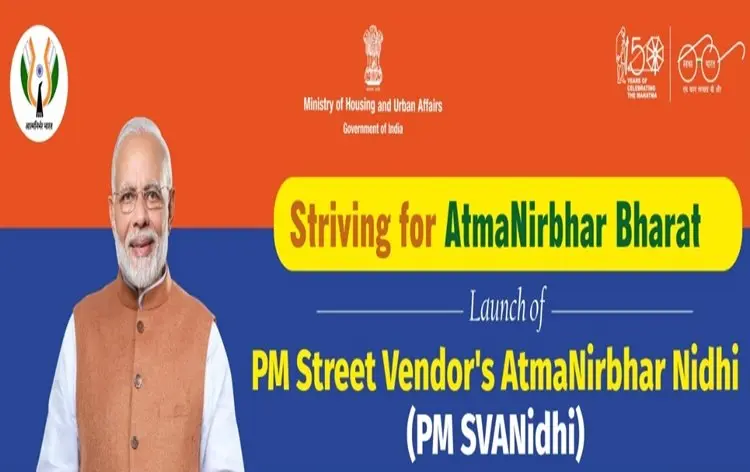PM SVANidhi Scheme: All you need to know about the Pradhan Mantri Street Vendor’s Atmanirbhar Nidhi Scheme
Prime Minister Modi interacted with the street vendors of Madhya Pradesh as a part of 'Svanidhi Samvaad' and praised them for ensuring cleanliness around them

PM SVANidhi Scheme: All you need to know about the Pradhan Mantri Street Vendor’s Atmanirbhar Nidhi Scheme
Prime Minister Modi interacted with the street vendors of Madhya Pradesh as a part of 'Svanidhi Samvaad' and praised them for ensuring cleanliness around them
Pradhan Mantri Street Vendor's Atmanirbhar Nidhi is a special micro-credit facility scheme for providing affordable loans to street vendors. The scheme enabled the street vendors to resume their livelihoods that have been adversely affected due to the COVID-19 lockdown. The scheme was launched in pursuance of the announcement made by Finance Minister Nirmala Sitharaman last month. In India's history, it is for the first time that street vendors from peri-urban or rural areas have become beneficiaries of an urban livelihood program.
The rationale behind the scheme is to provide working capital loans to street vendors. As we know that street vendors usually work with a small capital base which might have consumed during the lockdown period. So, the scheme will be helpful to resume their livelihoods.
Any person who works in vending of articles, goods, wares, food items, or merchandise of daily use or offering services to the general public during a street, footpath, pavement, etc. from either a temporary built-up structure or by moving from one place to another. The goods that are supplied by them are vegetables, fruits, ready-to-eat street food, tea, Pakodas, breads, eggs, textile, artisan products, books/ stationery, etc. and the services include barbershops, cobblers, pan shops, laundry services, etc.
The scheme targets to benefit over 50 lakh street vendors, who had been vending on or before 24 March 2020 in urban areas. As beneficiaries, the street vendors belonging to the surrounding peri-urban or rural areas are also included under the urban livelihoods program for the first time.
Prime Minister Modi stated via video conferencing, 'I congratulate all beneficiaries of the PM SVANidhi scheme. In my interactions with a few of them, I could see hope, and confidence in their talks. I also congratulate Chief Minister Shivraj Singh and his team for their efforts through which in just two months over one lakh street vendors have received the benefit under the scheme'.
Prime Minister Modi urged the small vendors to use digital modes of payments. For this, the bank officials will make a visit to the vendors and will provide them with the QR codes, along with the instructions.
Prime Minister spoke to three beneficiaries from Indore, Gwalior, and Raisen about the benefits received and the difficulties faced under the PM SVANidhi Scheme. He further inquired them about the businesses they had started and the COVID-19 effect on them.
Around 4.5 lakh vendors have registered under the scheme in Madhya Pradesh and more than 4 lakh vendors have already received the certificate. Under the PM SVANidhi scheme, 47% of the beneficiaries are from the state of Madhya Pradesh alone.
The scheme aims at facilitating working capital loans up to Rs. 10,000 at a subsidized rate of interest, incentivizing regular repayment of the loan and rewarding digital transactions. The scheme aims at providing benefits to street vendors or hawkers in urban, pre-urban, and rural areas on March 24, 2020, or before.
Features of the scheme
1- Initial working capital of up to Rs. 10,000.
2- Interest subsidy on timely or early repayment at the rate of 7%.
3- Monthly cash-back incentive on digital transactions.
4- Higher loan eligibility on timely repayment of the first loan.
Who will lend the credit to the vendors?
1- Scheduled Commercial Banks
2- Regional Rural Banks
3- Small Finance Banks
4- Cooperative Banks
5- Non-Banking Financial Companies
6- Micro-Finance Institutions
7- SHG Banks.
How to apply for the loan?
1- To apply for the loan, you need to have an identity card or vending certificate.
2- Visit a nearby Banking Correspondent (BC) or the Agent of Micro Finance Institution (MFI).
3- Upload all the necessary documents on the Mobile App.
What are the KYC documents required in addition to CoV/ ID / LoR?
1- Aadhaar Card
2- Voter’s Identity Card
3- Driving Licence
4- MNREGA Card
5- PAN Card
What is the amount of incentive for digital transactions?
1- On executing 50 eligible transactions, Rs. 50 will be transferred.
2- On executing the next 50 transactions, an additional Rs. 25 will be transferred.
3- On executing the next 100 transactions, an additional Rs. 25 will be transferred.
It is important to note that each transaction greater than Rs. 25 will be counted.
PM SVANidhi Scheme: Salient Features
- Initial working capital of up to Rs 10,000.
- In monthly installments, the loan is repayable in the tenure of one year.
- Interest subsidy of @7% on timely/early repayment. That is on timely and early repayment of the loan, an interest subsidy @ 7% per annum will be credited to the bank accounts of the beneficiaries through Direct Benefit Transfer on a six-monthly basis.
- On digital transactions incentives of monthly cash-back.
- On timely repayment of the first loan, there will be higher loan eligibility. That is if the street vendor repays the installments on time or earlier and will develop a credible credit score then he or she will be eligible for a higher amount of term loan to Rs 20,000.
In the implementation of the scheme, the Urban Local Bodies will play a significant role. The lending institutions under the scheme are Scheduled Commercial Banks, Regional Rural Banks, Small Finance Banks, Cooperative Banks, NBFCs, Micro Finance institutions, and Self Help Group banks.

Mobilizing technology for the empowerment:
- The Government's vision of supporting technology is to ensure effective delivery and transparency. And for this, a digital platform with a web portal/mobile app is being developed to administer the scheme with an end-to-end solution.
- In integrating the vendors the IT platform will also help in the formal financial system.
- To administer interest subsidy automatically, the platform will integrate the web portal/ mobile app with the UdyamiMitra portal of SIDBI for credit management and the PAiSA portal of MoHUA.
A capacity building and financial literacy program for all the stakeholders and IEC activities throughout the country will also be launched by MoHUA in collaboration with State Governments, State Missions of DAY-NULM, ULBs, SIDBI, CGTMSE, NPCI, and Digital Payment Aggregators during the month of June and loaning will commence in the month of July.
The Urban Local Bodies (ULBs) of the Town Vending Committees (TVCs) will identify the beneficiaries. The street vendors must possess the certificate of vending/identification issued by ULBs.
- PM SVANidhi or Pradhan Mantri Street Vendor's Atmanirbhar Nidhi scheme was launched on June 1, 2020, by the ministry of housing and urban affairs to help street vendors, who were impacted by the coronavirus pandemic, resume their livelihood activities.
- The scheme aims to provide working capital loans up to Rs 10,000 at a subsidized rate of interest.
- The interest subsidy on timely or early repayment of the loan is at 7 percent and street vendors will be allowed to repay the loan in monthly installments in one year.
The Ministry of Housing & Urban Affairs launched a scheme PM Street Vendor's AtmaNirbhar Nidhi (PM SVANidhi), on June 01, 2020. In a move to make this scheme more accessible, the Central Government recently launched the mobile application of the PM SVANidhi Scheme on July 17, 2020.
Starting New Year, over a million street vendors across India will accept and make payments digitally, having come on board for the ‘Main Bhi Digital (me too digital)’ drive designed by the Centre for them.
PM SVAnidhi's full form is “Pradhan Mantri Street Vendors AtmaNirbhar Nidhi“. This PM SVANidhi Yojana comes under the Aatm Nirbhar Bharat Scheme. This is scheme was launched after the Union Cabinet meeting on 1 June 2020, for the benefit of all the street vendors. PM SVANidhi scheme empowers all the Street Vendors to apply for the Rs. 10000 loan. This scheme is also known as the PM Street Vendors Atmanirbhar Nidhi.
Pradhan Mantri Street Vendor's Atmanirbhar Nidhi is a special micro-credit facility scheme for providing affordable loans to street vendors. The scheme enabled the street vendors to resume their livelihoods that have been adversely affected due to the COVID-19 lockdown. The scheme was launched in pursuance of the announcement made by Finance Minister Nirmala Sitharaman last month.
In India's history, it is for the first time that street vendors from peri-urban or rural areas have become beneficiaries of an urban livelihood program.
The rationale behind the scheme is to provide working capital loans to street vendors. As we know that street vendors usually work with a small capital base which might have been consumed during the lockdown period. So, the scheme will be helpful to resume their livelihoods.







